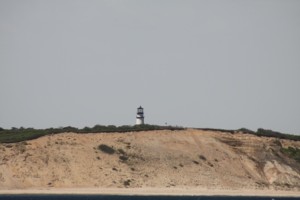Naturalist’s Notebook – May 14, 2016 to May 20, 2016
The naturalist on May 14 reports that the Dolphin VIII watched a rather unique encounter between a small finback whale and a kayaker. Apparently, the finner was circling the guy fast enough to cause a wake around him. The kayaker is reported to have looked scared.
The passengers of the afternoon trip witnessed an entangled whale. The naturalist reports that the Dolphin VIII stood by that whale for more than an hour and twenty minutes before it was successfully rescued by the whale disentanglement team from the Provincetown Center for Coastal Studies.
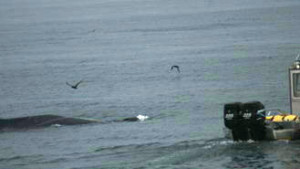
The Center for Coastal Studies has been disentangling large whales since the 1980’s when it became the only organization issued the federal permits that allow them to do it. All whales are protected by the Marine Mammal Protection Act and most of the large, baleen whales are also protected by the Endangered Species Act. Both acts prohibit actions that have the potential to injure a whale and actions that have the potential to change a whale’s behavior. The actions do not have to injure the whale or change its behavior, they merely have to have the potential of doing so. Since attempting to cut the gear that entangles the whale has both those potentials, special permits are required to even to attempt to rescue the whale from the gear.
Oddly enough, many of the techniques used by the rescuers of large whales have been adapted from the techniques of whalers. For example, the modern concept of kegging the whale is to throw a grappling hook into the lines that are trailing from its entanglement, Then, barrels (or kegs) are attached to the line to increase the drag and buoyancy of the whale. It has to work harder to dive deep and it has to work harder to swim. Both mean it gets tired faster and is forced to slow down and stay at the surface so it can breathe. This allows the disentanglement team to approach the animal and attempt to cut the lines that are wrapped around it free.
Historically, kegging the whale, meant that you threw a harpoon into the whale. Then, you attached the barrels to the lines on the harpoon for exactly the same reason. Except, then you pulled your boat up to the whale and slid a lance into one of the vital organs, killing the whale.
There were no trips on May 15 and May 16.
Wow! Reports of three different techniques of feeding from baleen whales were filed on May 17. The first and second reports come from the naturalist aboard the Dolphin X’s morning trip. A finback whale was seen lunging horizontally through the surface waters, its mouth agape and collecting schooling fish, as the raw inertia of the whale pushed it through the school of fleeing, panicked fish.
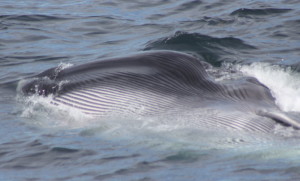
The second report, also from that trip, was of a single humpback whale, swimming in a circle beneath a school of forage fish, releasing a gentle stream of bubbles that sped up and thickened, trapping the fish in the path of the now opened mouth of the behemoth. Rising slowly from the deeper water beneath the school, the humpback scooped up a hundred or more pounds of small fish every time it repeated the process.
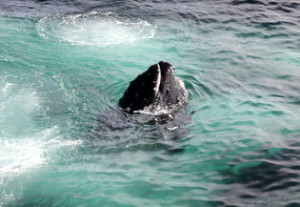
And in the afternoon, the report is of a right whale mother who, while her calf was busilly engage in doing not so terribly much, opened her mouth and pushed through the surface waters, turning back on herself repeatedly so that she made a series of track lines through the field of copepods. When she turned such that her open mouth was facing the vessel, the passengers could see the way the baleen hung down from just the upper jaw on both sides and they could make out that she had not baleen at the front of her mouth like a humpback or finback would. No, she had several hundred plates of baleen that was between six and eight feet tall hanging down from either side of her upper jaw but none in the front. Whether this was an adaptation that was brought on by the slow skim feeding style of the right whale or that style was the result of the placement of the baleen, nobody really knows. To the passengers of the Dolphin X, today, it didn’t really matter. All they knew was that watching this was just as exciting as watching a lunging finner or bubble-feeding humpback. It was just different.
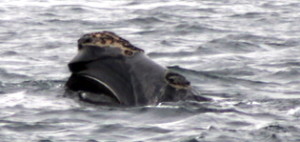
There were two species of whales sighted on May 18. A pod of 50 to 75 atlantic white-sided dolphins was found inside Provincetown harbor. These toothed whales, spread to both sides of the boat, delighted the passengers of the Dolphin VIII by leaping from the water, their color-streaked bodies shimmering in the sunshine.
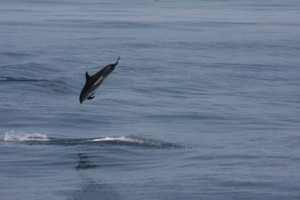
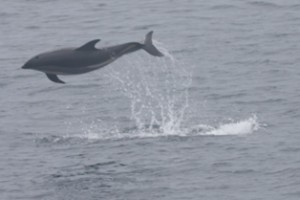
The second species of whale seen today was a finback whale. To be specific, a finback whale named “Skeg.” This whale was first photographed in the year 2000 and many times is an incredibly cooperative finwhale, allowing excellent, close-up views of its right side’s blaze and chevron. Today, Dennis Minsky reports, its “tall spouts hung in the air after mighty whooshes of exhalations.” (Sometimes, too, it allows excellent views of its more uniform left side.) Skeg is also far more likely to fluke up than other finners.
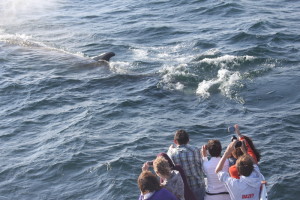
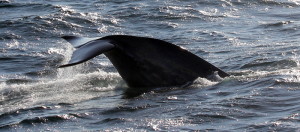
If you have been behind the wheelhouse on the whalewatch boat, how many times have you heard the expression, “A-plus Minke?” When the water’s flat, like on May 19, they are easier to get a look at and to follow as they move around beneath the surface. But today, the minke whale was not merely unaffected by the presence of the boat, it was curious about it. The passengers of the Dolphin X were treated to the curious attentions of a minke whale that spent some time swimming around the boat and giving good looks at the white patches on its flippers (called epaulettes). Even more incredibly, after its brief obsession with the Dolphin X was over, it began lunge-feeding, rolling over in the water to expose its rorqual pleats to all who were smart enough to look. The experience was “amazing,” according to the naturalist, Dennis Minsky.
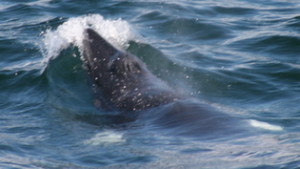
John Conlon also reports for this day that there were “great looks at parasitic jaegers between Wood End and Race Point. All with brilliant yellow neck/throat patches and long central tail feathers.” He further reports them as being scattered and flying low to the water.
And, for the birders, he also reports sightings of iceland and glaucous gulls. Both of these species should be disappearing to Northern Canada for their summer nesting seasons.
May 20 was a “gorgeous day,” says Liz Bradfield. Dennis Minsky says, we “looked and looked and looked and looked, and finally found a juvenile humpback whale on the shoaling waters off Longneck Beach.” The passengers of the Dolphin X enjoyed good looks at this animal,”against the stunning backdrop of the towering bluffs of oceanside Truro with Highland Light winking at us.”
